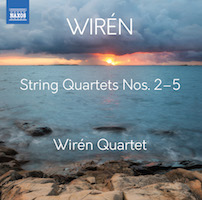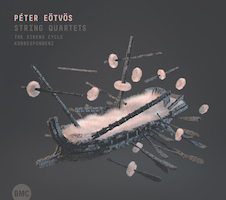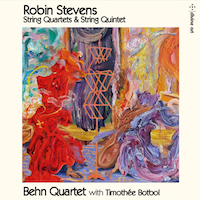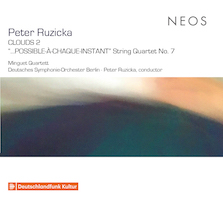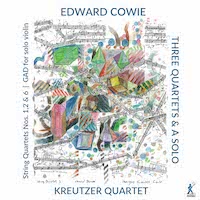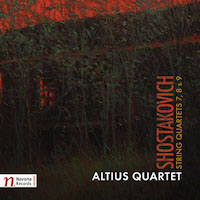String Theory 31: 15 Quartets and then some
|
Grant Chu Covell [July 2020.]
Dag WIRÉN: String Quartet No. 2, Op. 9 (1935); String Quartet No. 3, Op. 18 (1945); String Quartet No. 4, Op. 28 (1953); String Quartet No. 5, Op. 41 (1970). Wirén Quartet: Roger Olsson, Hans Elvkull (vln), Linn Elvkull (vla), Hanna Thorell (vlc). Naxos 8.573588 (1 CD) (http://www.naxos.com/). Wirén (1905-86) was a Swedish composer whose Paris studies in the 1930’s brought him into contact with Stravinsky. He wrote the music for Sweden’s entry to the 1965 Eurovision Song Contest, Annorstädes vals (“Absent Friend”). Warm and comforting, Wirén’s lovely Second unfolds with breezy tonality and a comfortable mastery of proportion and organic variation. No. 3 balances tunefulness with agitated rhythms, offering similarities with Janáček and Martinů. The Fourth explores ensemble range distributing melody and accompaniment between high violins and low cello. The five movements cleverly vary the initial material and two intermezzi between the first and fourth movements take a fantasy approach while a Lento turns sinister. The last quartet, No. 5, is darker still. Melodies become harder to spy, as if everything derives from accompaniment and transitions. Wirén clearly preferred quality over quantity; his First had been withdrawn.
Péter EÖTVÖS: The Sirens Cycle (2015-16)1; Korrespondenz (1992)2. Audrey Luna1 (sop), Calder Quartet1,2: Benjamin Jacobson, Andrew Bulbrook (vln), Jonathan Moerschel (vla), Eric Byers (vlc). Budapest Music Center Records BMC CD 249 (1 CD) (http://www.bmcrecords.hu/). Not just because The Sirens Cycle also includes soprano are these two quartets different in design and effect. Korrespondenz’s four players invent a complete universe, whereas the quartet supporting the singer seems extraneous with writing less specific to the instruments at hand. The impulsive Korrespondenz transcribes vowels from Leopold and Wolfgang Mozart’s letters. The words are never evident (they’re offered in the booklet), but the limber gestures indicate fraught conversation. Sirens’ is more conventional and less effective, perhaps reflecting that Eötvös leveraged a spectral analysis of the spoken texts (Joyce, Homer and Kafka) before putting pen to paper. There are ten settings from Ulysses sung in English, an interlude, a single excerpt from the Odyssey sung in Ancient Greek, and finally lines from Das Schweigen der Sirenen sung in German.
Robin STEVENS: String Quintet in C minor (1980-81; rev. 2018) 1; String Quartet No. 1 (2008)2; String Quartet No. 2, “Three Portraits” (2011)3. Timothée Botbol1 (vlc), Behn Quartet1,2,3: Kate Oswin, Alicia Berendse (vln), Ana Teresa de Braga e Alves (vla), Ghislaine McMullin (vlc). Divine Art DDA 25203 (1 CD) (http://www.divineartrecords.com/). This recording sets down a revision of Stevens’ Quintet. The composer was happy to reacquaint himself with youthful detours through Bartók, Berg and Debussy, with a bit of tango in the Scherzo. With its extra cello, the Quintet offers uneven sturdiness, like an upholstered chair on mismatched legs. The second cello vanishes beneath expressive blurring and overtightened harmony. The First quartet asserts itself. With sly counterpoint and an intensely engaged argument, this mature work connects with late Beethoven and Carter. The single movement churns and weaves over appealing material. The Behns admirably take another leap forward with the programmatic Three Portraits (“Impulsive One,” “God-seeker” and “Arguer,” plus a concluding Epilogue). No. 2 aligns with the traditional four-movement design, the programmatic movement titles ease our entry into the work.
Peter RUZICKA: Clouds 2 (2013)1; String Quartet No. 7, “…possible-à-chaque-instant” (2016)2. Minguet Quartett1,2: Ulrich Isfort, Annette Reisinger (vln), Aroa Sorin (vla), Matthias Diener (vlc). Deutsches Symphonie-Orchester Berlin1, Peter Ruzicka1 (cond.). NEOS 11808 (1 CD) (http://www.neos-music.com/). The Minguets and NEOS extend their Ruzicka series. Quartet No. 7, “…possible at any moment,” borrows its title from Paul Valéry. Material may derive from other music (there’s a gesture from Ruzicka’s Fifth Quartet and motifs that suggest Beethoven, et al.), however, ideas are introduced as if accidental intrusions poking through fog. The booklet’s notes offer a storefront view onto an intellectual laboratory, whereas the music’s 42-minute scale plots intentional fragments, an elegant contradiction, especially given a powerful culmination towards the end of the 5th track. I hear chimes in the final section which the booklet fails to corroborate. Clouds 2 revises an earlier effort for orchestra and string quartet, illustrating “distant sound” (linked by name with Schreker’s opera, “Der ferne klang,” but without specific quotation). The booklet provides miniaturized score pages, hard to parse for the Seventh and impenetrable for Clouds 2.
“Three Quartets and a Solo.” Edward COWIE: String Quartet No. 1, “Dungeness Nocturnes” (1969; rev. 2016)1; String Quartet No. 2, “Crystal Dances” (1977; rev. 2015-16)2; GAD (2017)3; String Quartet No. 6, “The Four Winds” (2012)4. Peter Sheppard Skærved3 (vln), Kreutzer Quartet1,2,4: Peter Sheppard Skærved, Mihailo Trandafilovski (vln), Clifton Harrison (vla) Neil Heyde (vlc). Metier MSV 28603 (1 CD) (http://www.divineartrecords.com/). At this release’s center is an autobiographical solo for violin, GAD, which reflects the composer wrestling with creative anxiety. In some ways, the challenges are on the surface in this lively, dissonant music. In these pieces, Cowie expresses his conviction that music is a biological phenomenon, that music ought to reflect Nature. But instead of Coates’ arcing smoothness, or John Luther Adams’ lulling tonality, we receive continual surprises, multi-faceted filigree, and material unfolding at independent tempi. As proven here, Cowie’s language is boldly consistent. The mature Sixth quartet, whose movements each represent one of the four winds, is easily comprehensible. The thread in Dungeness Nocturnes is harder to prise out, one need not be aware Nature is at the core to appreciate the continually changing vistas. Crystal Dances finds the quartet functioning as a unit. Ahead of notating a piece, Cowie will create prefatory paintings, and several are reproduced in the booklet.
Dmitri SHOSTAKOVICH: String Quartet No. 7 in F-sharp minor, Op. 108 (1960); String Quartet No. 8 in C minor, Op. 110 (1960); String Quartet No. 9 in E-flat major, Op. 117 (1964). Altius Quartet: Andrew Giordano, Joshua Ulrich (vln), Andrew Krimm (vla), Zachary Reaves (vlc). Navona NV6125 (1 CD) (http://www.navonarecords.com/). As a group, Nos. 7, 8 and 9 are three “personal” quartets. The Seventh was written in memory of Shostakovich’s first wife, Nina Vassilyevna, who had died in 1954. No. 8 is dedicated to victims of fascism and war; however, the consensus is that Shostakovich’s most popular quartet is autobiographical (and not just because the D-S-C-H motive appears). No. 9 is dedicated to his third wife, Antonovna Supinskaya (they wedded in 1962; Shostakovich married Margarita Kainova in 1956, but that marriage lasted only 3 years). The music we have today is actually Shostakovich’s second try at an E-flat quartet. The first attempt was penned in 1961 and only one original movement has surfaced. Arranged as a trilogy, No. 7’s aggression seems a dry run for No. 8. The Seventh’s final movement fugato could lurch into No. 8’s powerful keening or the notorious imitation of anti-aircraft guns. Rife with sneering motives and choppy accompaniments, these coarse sentences are unambiguous. Do we appreciate them because they are personal and because we sympathize with Shostakovich’s plight? Shostakovich learned from Mahler’s overlap of high and low (viz. Symphony No. 5’s “new” direction), and perhaps someday a quartet will emphasize the romantic and downplay the militant. Maybe there could have been greater abandon in No. 8’s desolate parts, indeed the contrasts that lead to the aggressive second movement could have been cranked up.
[Previous Article:
Chiaroscuro]
[Next Article:
How to Practice During a Pandemic II]
|
